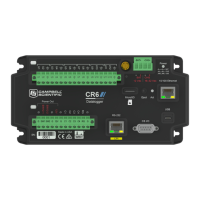11.5.3 Period-averaging measurement specifications
Use PeriodAvg() to measure the period (in microseconds) or the frequency (in Hz) of a signal
on a single-ended channel.
Terminals: U terminals 1-12
Accuracy: ±(0.01% of measurement + resolution), where resolution is 0.13 µs divided by the
number of cycles to be measured
Ranges:
l Minimum signal centered around specified period average threshold.
l Maximum signal centered around data logger ground.
l Maximum frequency = 1/(2 * (minimum pulse width)) for 50% duty cycle signals
Gain
Code
Option
Voltage
Gain
Minimum
Peak to Peak
Signal (mV)
Maximum
Peak to Peak
Signal (V)
Minimum
Pulse Width (µs)
Maximum
Frequency (kHz)
0 1 500 10 2.5 200
1 2.5 50 2 10 50
2 12.5 10 2 62 8
3 64 2 2 100 5
See also Period-averaging measurements (p. 77).
11.5.4 Static vibrating wire measurement specifications
Up to 6 static vibrating wire measurements without thermistor measurements, or up to 3 static
vibrating wire measurements with thermistor measurements. A U terminal pair both excites and
measures vibrating wire transducers. Logarithmic sine-wave-frequency excitation is adjustable up
to ±6 V (12 V peak-to-peak), programmable from 100 Hz to 6.5 kHz, then followed by frequency
domain measurements, one at a time.
Terminals: U1 - U12
Input Resistance: 4.75 kΩ
Measurement Type: Differential voltage
Range: ±200 mV
Accuracy: ±0.013% of reading
Resolution: 0.001 Hz RMS
Measurement Speed (vibrating wire and thermistor combined): < 1 s
11. CR6 Specifications 219

